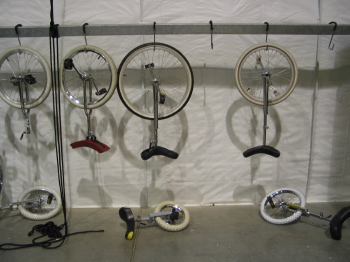The Circus Family
Circus Juventas


Eight glittery acrobats pose and twirl overhead in the lobby of Circus Juventas’ St. Paul facility. Sculpted with coils of bright copper wire, the mobile of figures frozen in various circus acts symbolizes the interdependent, interwoven phenomenon that is the circus family.
Circus Juventas–named after an early Roman goddess of youth–began its life in 1994 as Circus of the Star, a small program in St. Paul’s Highland neighborhood dedicated to instructing youth in the circus arts. Founders Dan and Betty Butler, who first met at the Sailor Circus program in Sarasota, Florida, in the mid-1970s, started with about thirty students and borrowed space in a neighborhood recreation center. Since then, they have regularly performed at St. Paul’s Capital New Year festivities and in conjunction with the annual Highland Fest in August. In May 2002 they staged their first Spring Celebration performances in their new facility in Highland, a permanent building with 21,000 square feet of floor space and a forty-foot ceiling–just enough room for a performing cast of nearly three hundred, ranging from toddlers to college students, plus the support crew of riggers and spotters, back- and offstage areas, and bleachers accommodating hundreds of family members, friends, and, increasingly, patrons enjoying the spectacle of physical theater.
“Cirque Napoleon,” this year’s August presentation, involved a smaller cast of more experienced performers (most had been with the program at least four years) and a thoroughly developed staging integrating music, lighting, choreography, and costuming. All this accompanies the astounding athleticism and dramatic flair of the students. Among the twenty-eight acts, new entries including high wire, flying trapeze, and bungee trapeze (four elegantly synchronized bouncers who dropped from three stories up in the rigging) demonstrated the big top’s capaciousness and versatility–and the realized ambitions of the veteran performers.
Swarming in the shadows below the spotlights throughout the performance, discrete in dark clothes and heavy leather work gloves, were figures whose t-shirts identified them as either “rigger,” “coach,” or “crew.” (During intermission and a break between a matinee and evening performance, performers donned their own black t-shirts, though make-up and costumes singled them out very effectively.)
In the concrete lobby floor underneath the mobile–made by Lizzie Cavanaugh-Broad, one of the daring young women on “Cirque Napoleon”‘s flying trapeze–are inset rectangles of glossy black stone, each celebrating significant circus patrons. More than a half dozen of these inscribed stars acknowledge families (and the occasional family foundation–this is a nonprofit organization). Indeed, family involvement is integral to the circus undertaking, on both financial and more tangible terms. Many families have enrolled multiple children over the seven years of the class program, including four from the founding Butler family, three Petty daughters, and two of instructor Alexander “Sasha” Svirshch’s children. Many of the “roustabout” rigging crew are fathers of performers, and most of the backstage crew is also recruited from the family ranks.
The quandary of defining “circus”–as education, sport, or art–pales beside the increasing evidence of its popularity and the network of engaged participants. Circus Juventas is one of a small handful of youth and collegiate-level circus training programs, along with a select group of professional performing troupes, in North America; in contrast, there are scores of training programs and family circuses large and small in Europe and Asia, indicating a more established cultural role for circus activity (and room to grow in this country). The Circus Juventas facility itself draws attention among the itinerant artists and aerialists now performing in both high art and broad public entertainment contexts. Brooklyn-based choreographer Sarah East Johnson and her troupe LAVA connected with Circus Juventas while they were in town performing at Walker Art Center as part of Dyke Night 12 this past June.
Other recent appearances of circuses and their ilk include: Cirque du Soleil, whose portable tent on the downtown Minneapolis Riverfront housed their “Alegria” performances during August and September; 3 Legged Race‘s “circus-fueled” “Summer Blizzard 2002,” five acts (including some Circus Juventas alums) in which “clowning, aerialism and object manipulation merge with theater and dance to create–you tell us!”; Dreamcast Entertainment‘s “Balagan” show–“xtreme aerial art,” as their web site puts it–for Marshall Fields’ 2001 “Glamorama” fund raiser; and the “aerial dance theater” (“‘Circus’ is hardly a word we use,” says Bacon) of
Sally Rousse and Chelsea Bacon’s “trickpony,” which appeared at the Southern Theater in early September.
This interwoven structure of camaraderie and creativity underscores the inclusive appeal of circus arts as practiced by Circus Juventas. In this facility and this non-competitive, though nonetheless impressively rigorous and physically challenging program, all are welcome and encouraged to participate at whatever level they can. This applies to both students and their families, all of whom have roles in the proverbial, and necessary, cast of thousands.
Photographs by George Slade